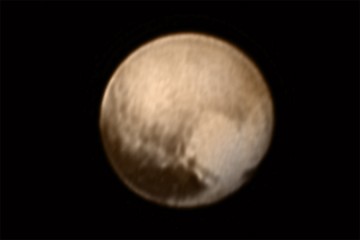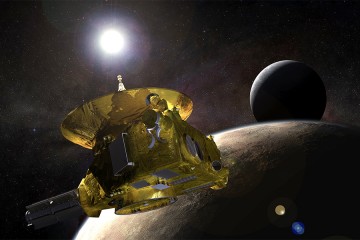They're a fascinating pair, Pluto and Charon, two icy worlds, spinning around a common center of gravity like a pair of figure skaters clasping hands.
New images from NASA's New Horizons spacecraft—designed, built, and operated by the Johns Hopkins Applied Physics Laboratory—are yielding new insights into these distant worlds at the edge of our solar system. Scientists believe they were shaped by a cosmic collision billions of years ago, and yet, in many ways, they seem more like strangers than siblings.
A high-contrast array of bright and dark features covers Pluto's surface, while on Charon—the dwarf planet's smaller moon—only a dark polar region interrupts a generally more uniform light gray terrain. The reddish materials that color Pluto are absent on Charon. Pluto has a significant atmosphere; Charon does not. On Pluto, exotic ices like frozen nitrogen, methane, and carbon monoxide have been found, while Charon's surface is made of frozen water and ammonia compounds. The interior of Pluto is mostly rock, while Charon contains equal measures of rock and water ice.
"These two objects have been together for billions of years, in the same orbit, but they are totally different," said Alan Stern of the Southwest Research Institute in Boulder, Colorado, principal investigator of the decade-long New Horizons mission to Pluto.
Charon is about 750 miles across—roughly half the diameter of Pluto—making it the solar system's largest moon relative to its planet. Its smaller size and lower surface contrast have made it harder for New Horizons to capture its surface features from afar, but the most recent,closer images of Charon's surface, sent from the spacecraft on Wednesday, show intriguing fine details.
Newly revealed are brighter areas on Charon that members of the mission's Geology, Geophysics and Imaging team (GGI) suspect might be impact craters. If they are, the craters could help scientists learn even more about the mysterious moon.
"If we see impact craters on Charon, it will help us see what's hidden beneath the surface," said GGI leader Jeff Moore of NASA's Ames Research Center. "Large craters can excavate material from several miles down and reveal the composition of the interior."
In short, said GGI deputy team leader John Spencer of Southwest Research Institute, "Charon is now emerging as its own world. Its personality is beginning to really reveal itself."
Posted in Science+Technology
Tagged applied physics laboratory, space exploration, nasa, new horizons











